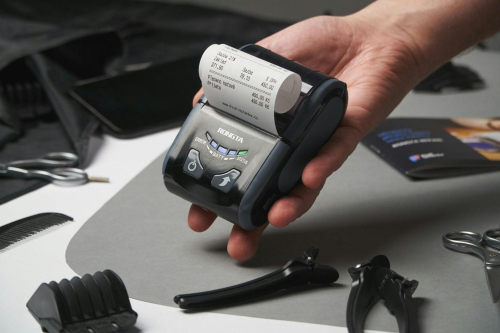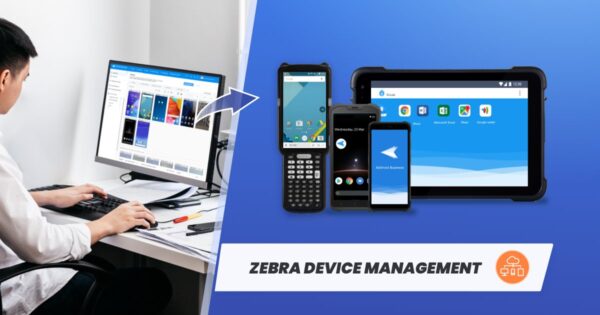Zebra MDM vs Popular Third-Party MDMs Compared
As an original equipment manufacturer (OEM), Zebra has a line of popular computers, tablets, scanners, and printers. Unlike typical smartphones or tablets, Zebra’s devices often have custom hardware, such as barcode scanners.
Zebra offers businesses its own MDM to help organizations better manage, monitor, and protect their devices. There are also many third-party MDMs that support Zebra. Because Zebra MDM and third-party MDMs each have their own strengths and weaknesses, organizations must understand these differences to choose the best option for their needs.
IOverview of Zebra’s Managed Device Service
Organizations that have Zebra devices may want to first consider their three solutions or Zebra’s Managed Device Service.
1.1 What Is Zebra’s In-House MDM Offering?
Zebra offers several solutions to manage their devices.
- The first is LifeGuard for Android, a security service that enables businesses to deliver OS and patch updates OTA to Zebra’s rugged devices.
- With StageNow, IT admins can deploy Zebra devices through two options: scanning a barcode or tapping an NFC tag.
- Finally, VisibilityIQ is Zebra’s analytics platform, providing IT administrators with full insight into device health, usage, and performance.
Businesses may not want to adopt and learn three individual solutions to manage their Zebra devices. These businesses may prefer to use Zebra Managed Device Services, in which case they would serve as a dedicated support desk for the organization’s Zebra devices.
This support would extend across the entire lifecycle of Zebra devices, encompassing deployment, troubleshooting, and device decommissioning.
1.2 Key Benefits
As the OEM, Zebra is naturally the expert on their own devices. Organizations that rely primarily or exclusively on Zebra devices may benefit from using its three products or MDS. These technologies are deeply and natively integrated into Zebra devices, providing organizations with enormous control and powerful customization through full-stack integration.
Unlike other MDMs, Zebra’s solutions also provide full support to all their devices, such as printers, which may be critical for some businesses.
Organizations that outsource the administration of Zebra devices to MDS can also rely on best-in-class expertise for deploying, managing, and troubleshooting their hardware. These experts can help organizations maximize their use of Zebra devices.

1.3 Limitations
LifeGuard for Android, StageNow, VisibilityIQ, and MDS are all Zebra-centric, as they are built and optimized for Zebra devices.
Organizations with multiple device types and brands may not find their needs fully addressed by the Zebra suite.
Zebra’s products and MDS are also cost-prohibitive for most businesses. Zebra’s price structure is geared toward enterprises, with a high cost and long contract terms.
Adopting Zebra’s products or MDS may weigh enterprises down with significant sunk costs, both financially and technologically.
Businesses that wish to remain agile would be better served by one of several third-party MDMs on the market.
IIOverview of Third-Party MDM Supporting Zebra
There are many third-party MDMs supporting Zebra. One popular choice is AirDroid Business, which is compatible not only with Zebra but also with a wide range of Android-powered devices.
2.1 Zebra Management Features
Zebra’s rugged devices are typically in the field. If they break down, enterprises without an MDM will typically have to deploy a technician to fix the issue.
With AirDroid Business, businesses can remotely troubleshoot and restore the Zebra device, minimizing downtime. The IT admin can take full control over the device to conduct this restoration.
Businesses can also manage app installations and updates for all Zebra devices through AirDroid Business.
They can whitelist or blocklist apps, schedule the release or update of new apps, and monitor app usage to ensure none are getting misused. Businesses can even elect to lock down a Zebra device to a single app with Kiosk Mode.
App management is one component of the broader policy that organizations can set for their Zebra devices. IT admins can configure their Zebra devices through AirDroid Business with the same level of customization and granularity as the Zebra MDM.
2.2 Key Benefits
Organizations rarely have only Zebra devices. AirDroid Business is beneficial to mixed-device organizations because of its cross-platform support.
In addition to providing exceptional support for Zebra devices, AirDroid Business offers similarly comprehensive solutions for smartphones, tablets, kiosks, smart TVs, and other devices across a wide range of brands.
Businesses that opt for AirDroid Business have consistent control over their device ecosystem. For example, they can monitor the salesperson using a Samsung smartphone, as well as the truck driver using a Zebra tablet.
There is also greater control. Unlike the enterprise-focused cost structure of Zebra’s MDM, AirDroid Business caters to businesses of all types.
In principle, this flexibility means that a small business can utilize AirDroid Business for its initial ten employees and continue with the solution as it scales to become an enterprise.

2.3 Limitations
- AirDroid Business offers limited support for Zebra printers.
- Zebra’s MDM will always be first-to-market with its own firmware or updates. As a third-party platform, AirDroid will receive these updates eventually, but they will be implemented later after a development and integration period.
IIIThird-Party MDM Options Deep Dive
In addition to AirDroid Business, several other third-party MDMs also provide support for Zebra devices.
Microsoft Intune
Many enterprises already use Microsoft 365 for their general productivity suite. These businesses may prefer to use Microsoft Intune as their MDM to integrate with Zebra.
IT admins can configure Zebra-specific settings through Microsoft Intune thanks to its support for Zebra’s OEMConfig app.
Intune is also compatible with Zebra LifeGuard, so firmware updates can be pushed OTA through the MDM. Microsoft Intune also carries the same strengths as Microsoft 365, including access management, compliance reporting, and enterprise scalability.
Hexnode
As a Zebra partner, Hexnode leverages OEMConfig for Zebra device management. After deploying Zebra’s OEMConfig app through a Managed Google Play Store, IT admins can enroll devices, use modes such as kiosk lockdown and remote view, and even configure advanced features like barcode scanning.
Hexnode users can also update via LifeGuard firmware. The solution supports integration with both Azure AD and Google Workspace, simplifying the standardization of permissions for Zebra devices.
MaaS360
MaaS360 is an IBM cloud service. Integrated with IBM’s enterprise security suite, MaaS360 supports Zebra OEMConfig apps on Android 11 and above, as well as legacy Android versions 11 and below.
Maas360 may be ideal for enterprises with very large Zebra deployments, as the solution offers multi-tenant deployment, device tracking, analytics, and reporting.
IVWhich Is Right for Your Business?
There are some cases when choosing Zebra’s MDM is better, and others where a third-party will work better for your needs.
4.1 When to Choose Zebra’s MDM
The Zebra MDM is ideal for homogeneous device environments, where the business only has Zebra devices. There is an even greater fit if the business has extensive printing demands, such as those in logistics or retail, and low IT overhead.
While Zebra MDM does support other hardware, the platform was purpose-made for Zebra devices. As such, it does not provide as robust or comprehensive support as device-agnostic MDMs.
4.2 When to Choose a Third-Party MDM
Most businesses have heterogeneous device environments, where employees use devices from different manufacturers, depending on their individual needs.
For example, a salesperson may need a tablet for on-the-go presentations, while a factory worker may require a rugged device to withstand the rough environment.
These mixed-device businesses should use a third-party MDM that is optimized for many device types.
Even with this diversity, such businesses will still be able to exert advanced policy control over all their devices, including app management, whitelisting, and geofencing.
These MDMs are also frequently ideal for organizations that need budget flexibility: With no lock-in periods or minimum deal sizes, businesses can scale their named users as their organization grows.
4.3 Decision Factors
- When deciding between Zebra’s MDM and a third-party MDM, organizations should consider the cost of procuring and implementing the solution.
- They should also evaluate whether the solution can cater to the deployment scale they need.
- Finally, businesses should also consider the vendor’s skill set and whether they can provide the necessary support to guide the MDM implementation to long-term success.
FAQs







Leave a Reply.